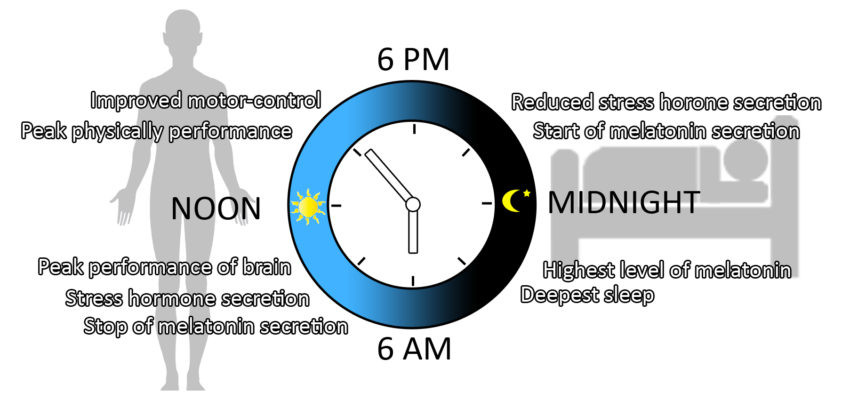
Circadian clock, sleep and the regulation of the human body
27.09.2016 / Scienceandmore / Category: Human Biology
The circadian rhythm, also called circadian clock or just inner clock, is the endogenous capability of an organism to retain a 24 h rhythm without being exposed to environmental stimuli that indicate the time of day. Animals, plants and even fungi generate a circadian rhythm and plays a major role in daily live.
For humans it is the mechanism to regulate sleep and wakefulness. Interestingly, during the first half year of life, as infants, humans do not have a working circadian rhythm, which explains why babies have an erratic sleeping pattern. They wake up in the middle of the night and are wide awake, much to the suffering of the parents. At around three to six months of age, the circadian clock starts to get established, and babies begin to sleep at night and are awake during the day.
How are sleep and wakefulness regulated?
There are two mechanisms or systems that take care of sleep and wakefulness. This first is the “sleep and wake homoeostasis”, which is a balance-system of sleep and wakefulness. It measures the ratio of both, and in case of insufficient sleep over a longer period of time the need for sleep will accumulate, resulting in the enhanced feeling of sleepiness. The sleep-wake homoeostasis system is also responsible for continuous sleep throughout the night.
The second regulator of sleep and wakefulness is the circadian clock, and it regulates the timing of both states. In general, the circadian clock’s strongest effect on sleep occurs between 2 and 4 o’clock at night, when people are in their deepest sleep. At this time, the body’s production of the sleep hormone melatonin is at its highest level.
Upon awakening in the morning, melatonin levels are strongly reduced, and instead stress hormone levels, such as cortisol, rise. This is also the time when the circadian clock ensures that the body’s digestive system is animated and that the brain starts to reach peak performance; ready for analysing, decision making, altogether ready for work.
In the afternoon, the circadian clock improves motor-control to ensure peak physically performance.
In the evening, the circadian clock prepares the organism for sleep by slowing down the metabolism, reducing stress-hormone levels and again increasing melatonin levels that reach peak levels between 2 and 4 o’clock at night; thereby closing the cycle.
Overall, the circadian clock gets the organism into a rhythm that attunes it for reoccurring events and regulates daily processes. But how is rhythm regulated?
Light and darkness are the key players here, especially the timing when they are perceived. Light, obviously, is sensed by specific photoreceptors of the eye’s retina. Studies in rodents found that entrainment of the circadian rhythm depends on melanopsin that has peak sensitivity to light of around 480 nm wavelength, and opsin of the cones that has peak sensitivity to light of above 500 nm wavelength (middle wavelength-opsin in the outer retina). Therefore, melanopsin perceive the blue light proportion of daylight and conveys blue light signals. The participation of other retina photopigments in entrainment is, however, not excluded.

The subsequently created signal is transferred to an area in the brains that is part of the hypothalamus and is called Suprachiasmatic Nucleus (SCN), or “master clock”. During the day, melanopsin-mediated stimulation of the SCN prevents the production of the sleep hormone melatonin, resulting in wakefulness. Conversely, during the evening/night, when blue light mediated stimulation of the SCN is reduced, melanin is produced, resulting in sleepiness. The SCN is also responsible for the downregulation of the core body temperature at this time. Thus, the feeling of being cold is much stronger during the night.
The inhibiting effect of blue light on the melatonin production at night could results in low-quality sleep during the night. This is where people’s most common hobby, work and general pursuit come into play: computers, tablets, phones and their screens. They emit blue light and we use them until late at night; we have a quick look at our phones before we go to sleep. By doing so, the circadian clock gets jumbled and, thereby, the whole day-night rhythm. This could results in difficulties to fall asleep, light sleep and a feeling of being unrested.

Helpful tips for better sleep
Interruptions of sleep at night should be avoided, and in case that this is not possible, for instance by a visit of the bathroom, light should not be switched on. Of course only in case it is ensured that movement in the house, flat, rooms, and so on, during darkness is safe!
It is important to realise that closed eyes do not prevent light from being perceived and the resulting signal from being transferred to the SCN. Sleeping when the sun is up will not allow for the most restful sleep. The bedroom should be dark, or, as an alternative, a dark sleeping mask cold be worn.
Screens, especially mobile phone and computer screens, emit a high proportion of blue light. Avoidance of looking at screens before bedtime would be very beneficial for sleep onset and sleep quality. Alternatively, the program f.lux® could be utilised. It tracks sunset and gradually changes the colours of the light emitted by the computer and mobile phone screen, removing the blue light proportion at night. Also, blue light blocking glasses could be worn in the evening and at night.
References
Panda, S. (2007) Multiple Photopigments Entrain the Mammalian Circadian Oscillator. Neuron 53, 619-621.
Partch, C.L., Green, C.B., and Takahashi, J.S. (2014) Molecular Architecture of the Mammalian Circadian Clock. Trends Cell Biol.24(2), 90-99.
Tosini, G., Ferguson, I., Tsubota, K. (2016) Effects of blue light on the circadian system and eye physiology. Molecular Vision 22, 61-72.
http://justgetflux.com
